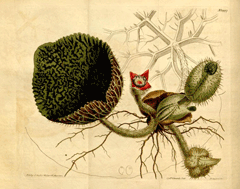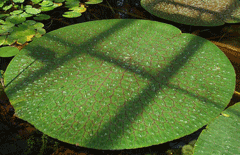 |
|
http://commons.wikimedia.org/wiki/File:Euryale_ferox.jpg |
 |
| http://commons.wikimedia.org/wiki/User:Selso |
Translate this page:
Summary
Physical Characteristics

 Euryale ferox is a PERENNIAL growing to 1 m (3ft 3in) by 3 m (9ft).
Euryale ferox is a PERENNIAL growing to 1 m (3ft 3in) by 3 m (9ft).
See above for USDA hardiness. It is hardy to UK zone 8. The species is hermaphrodite (has both male and female organs).
Suitable for: light (sandy), medium (loamy) and heavy (clay) soils. Suitable pH: mildly acid, neutral and basic (mildly alkaline) soils. It cannot grow in the shade. It can grow in water.
UK Hardiness Map
US Hardiness Map
Synonyms
Plant Habitats
Pond;
Edible Uses
Edible Parts: Fruit Seed Stem
Edible Uses:
Fruit[2]. Soft and pulpy, it is about the size of a small orange[2]. It is highly esteemed in China as a cooling tonic food[183]. Seed - fresh or dried[183, 200]. The seed is about the size of a pea, each fruit containing from 8 to 15 seeds[2]. The seed is usually roasted and then eaten[218]. It is also used as a source of starch[183]. A nutritional analysis is available[218]. Very young stalks and rhizomes[2, 183]. Rich in starch[2].
References More on Edible Uses
| Composition
|
| Figures in grams (g) or miligrams (mg) per 100g of food.
|
|
|
Seed (Dry weight)
|
|
- 400 Calories per 100g
- Water : 0%
- Protein: 10.3g; Fat: 0.2g; Carbohydrate: 89g; Fibre: 0.2g; Ash: 0.6g;
- Minerals - Calcium: 34mg; Phosphorus: 100mg; Iron: 1.5mg; Magnesium: 0mg; Sodium: 0mg; Potassium: 66mg; Zinc: 0mg;
- Vitamins - A: 0mg; Thiamine (B1): 0mg; Riboflavin (B2): 0mg; Niacin: 0mg; B6: 0mg; C: 0mg;
- Reference: [ 218]
- Notes:
|
|
Medicinal Uses
Plants For A Future can not take any responsibility for any adverse effects from the use of plants. Always seek advice from a professional before using a plant medicinally.
Analgesic Aphrodisiac Astringent Deobstruent Oxytoxic Tonic
The leaf is used in cases of difficult parturition[218]. All parts of the plant are considered to be astringent, deobstruent and tonic[218]. The seed is a sweet and sour astringent herb that acts as a tonic for the kidney and the spleen[238]. The seed is analgesic and aphrodisiac[218]. It is taken internally in the treatment of chronic diarrhoea, vaginal discharge, kidney weakness associated with frequent urination, impotence, premature and involuntary ejaculation and nocturnal emissions[238, 279].
References More on Medicinal Uses
The Bookshop: Edible Plant Books
Our Latest books on Perennial Plants For Food Forests and Permaculture Gardens in paperback or digital formats.

Edible Tropical Plants
Food Forest Plants for Hotter Conditions: 250+ Plants For Tropical Food Forests & Permaculture Gardens.
More

Edible Temperate Plants
Plants for Your Food Forest: 500 Plants for Temperate Food Forests & Permaculture Gardens.
More

More Books
PFAF have eight books available in paperback and digital formats. Browse the shop for more information.
Shop Now
Other Uses
References More on Other Uses
Cultivation details
Management: Standard Regional Crop Staple Crop: Balanced carb
A water plant, it requires a rich soil, preferably growing in still water[238]. It can be grown in still or slowly flowing water[200]. In cultivation in temperate greenhouses, the plant is often grown as an annual[200]. It requires about 0.75 cubic metres of root run[200]. This species is not very cold hardy. One report says that it succeeds in zone 8[200] which would mean that it tolerates temperatures down to between -5 and -10°c but this must be viewed with some doubt. It is unlikely to succeed outdoors in Britain, at least when grown as a perennial[K]. Frequently cultivated as an edible plant in China and India, the seeds are normally available in Chinatown markets in the West[183].
Carbon Farming
-
Management: Standard
Plants grow to their standard height. Harvest fruit, seeds, or other products. Non-Destructive management systems.
-
Regional Crop
These crops have been domesticated and cultivated regionally but have not been adopted elsewhere and are typically not traded globally, Examples in this broad category include perennial cottons and many nuts and staple fruits.
-
Staple Crop: Balanced carb
(0-15 percent protein, 0-15 percent oil, with at least one over 5 percent). The carbohydrates are from either starch or sugar. Annuals include maize, wheat, rice, and potato. Perennials include chestnuts, carob, perennial fruits, nuts, cereals, pseudocereals, woody pods, and acorns.
References Carbon Farming Information and Carbon Sequestration Information
Temperature Converter
Type a value in the Celsius field to convert the value to Fahrenheit:
Fahrenheit:
The PFAF Bookshop
Plants For A Future have a number of books available in paperback and digital form. Book titles include Edible Plants, Edible Perennials, Edible Trees,Edible Shrubs, Woodland Gardening, and Temperate Food Forest Plants. Our new book is Food Forest Plants For Hotter Conditions (Tropical and Sub-Tropical).
Shop Now
Plant Propagation
Seed - best sown as soon as it is ripe, the seed has a short viability and must not be allowed to become dry. Sow the seed in pots in a greenhouse at about 21°c and immerse the pots in water. As soon as they are large enough to handle, prick the seedlings out into individual pots and grow them on in the greenhouse for at least their first winter. Plant them out into their permanent positions in late spring or early summer, after the last expected frosts.
Other Names
If available other names are mentioned here
Native Range
TEMPERATE ASIA: Russian Federation (Primorye), China (Anhui Sheng, Fujian Sheng, Guangdong Sheng, Guangxi Zhuangzu Zizhiqu, Guizhou Sheng, Hainan Sheng, Hebei Sheng, Heilongjiang Sheng, Henan Sheng, Hubei Sheng, Hunan Sheng, Jiangsu Sheng, Jiangxi Sheng, Jilin Sheng, Liaoning Sheng, Nei Mongol Zizhiqu, Shaanxi Sheng, Shandong Sheng, Shanxi Sheng, Sichuan Sheng, Yunnan Sheng, Zhejiang Sheng), Japan (Honshu, Kyushu), Korea, South, Taiwan TROPICAL ASIA: Bangladesh, India (Assam, Bihar, Jammu and Kashmir, Manipur, Meghalaya, Rajasthan, Tripura, Uttar Pradesh, West Bengal), Myanmar (north)
Weed Potential
Right plant wrong place. We are currently updating this section.
Please note that a plant may be invasive in one area but may not in your area so it's worth checking.
Conservation Status
IUCN Red List of Threatened Plants Status :

Growth: S = slow M = medium F = fast. Soil: L = light (sandy) M = medium H = heavy (clay). pH: A = acid N = neutral B = basic (alkaline). Shade: F = full shade S = semi-shade N = no shade. Moisture: D = dry M = Moist We = wet Wa = water.
Now available:
Food Forest Plants for Mediterranean Conditions
350+ Perennial Plants For Mediterranean and Drier Food Forests and Permaculture Gardens.
[Paperback and eBook]
This is the third in Plants For A Future's series of plant guides for food forests tailored to
specific climate zones. Following volumes on temperate and tropical ecosystems, this book focuses
on species suited to Mediterranean conditions—regions with hot, dry summers and cool, wet winters,
often facing the added challenge of climate change.
Read More
Expert comment
Author
Salisb.
Botanical References
58266
Links / References
For a list of references used on this page please go here
Readers comment